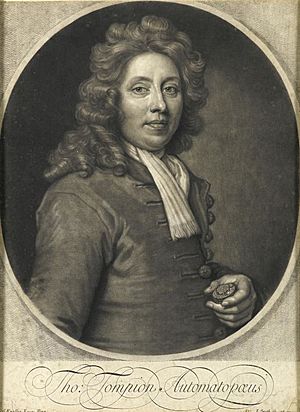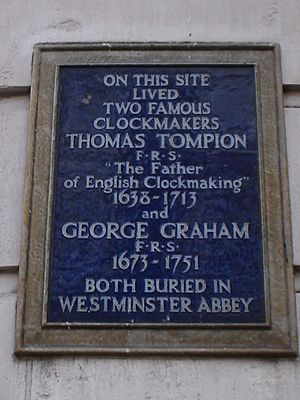Thomas Tompion facts for kids
Quick facts for kids
Thomas Tompion
|
|
|---|---|

Engraving of Thomas Tompion by John Smith, after a portrait by Sir Godfrey Kneller
|
|
| Born | 1639 Northill, Bedfordshire, England
|
| Died | 1713 London, England
|
| Nationality | English |
| Occupation | Clock- and watchmaker |
Thomas Tompion (1639–1713) was a very famous English clockmaker and watchmaker. Many people still call him the "Father of English Clockmaking" today. His clocks and watches are some of the most important and historic in the world. When his amazing creations are sold, they can fetch very high prices. A special plaque in Fleet Street in London marks the house where he lived. He shared this house with his equally famous student, George Graham.
Contents
The Life of Thomas Tompion
Thomas Tompion was born around 1639. He was baptized on July 25, 1639, in a village called Northill in Bedfordshire, England. There is a plaque on his family's old home in Ickwell, put there in 1952 by the Worshipful Company of Clockmakers.
Thomas was the oldest son of a blacksmith, who was also named Thomas Tompion. He probably worked as a blacksmith himself until 1664. That year, he became an apprentice to a clockmaker in London. We don't know much about his early life. We first hear about him in London around late 1670, living near Fleet Street.
How Tompion Became Famous
Tompion's early work showed a strong connection to another clockmaker, Joseph Knibb. A very important person who supported Tompion early on was the scientist Robert Hooke. Hooke might have known the Knibb family from Oxford.
Hooke's friendship with Tompion was key to his success. It helped him get work for the King and gave him access to the newest ideas in technology.
Tompion was excellent because his designs were strong and he used high-quality materials. He also hired very skilled workers. Many of these workers were Huguenots, who were French and Dutch craftspeople. Their amazing skills helped Tompion build his great reputation.
Tompion joined the Clockmakers' Company of London in 1671. This was a group for clockmakers. He became a master in 1704, working with other famous members like Charles Gretton and Daniel Quare.
Clocks for the King and Science
When the Royal Observatory was built in 1676, King Charles II chose Tompion to make two special clocks. These clocks were based on Robert Hooke's idea for a very long pendulum.
The clocks were placed in the Octagon room. They only needed to be wound once a year! They were very accurate and helped scientists make correct calculations for studying the stars.

Because of his connection with Robert Hooke, Tompion made some of the first watches with balance springs. These watches could be much more accurate than older ones. They tried different types of springs. One watch was made for King Charles II.
This special watch was signed, saying "Robert Hooke invent. 1658. T. Tompion fecit, 1675". This means Hooke invented it in 1658, and Tompion made it in 1675. Sadly, this watch does not exist anymore.
Tompion's workshop built about 5,500 watches and 650 clocks during his career. His clocks are known for their clever design and strong build. His special "grande sonnerie" clocks are true masterpieces. These clocks and his repeating watches are very complex and interesting to people who love mechanics.
Another clever idea from Tompion was to use a numbering system for his clocks and watches. This was one of the first times that serial numbers were used for manufactured goods.
Later Years and Legacy
Tompion worked with Edward Banger from 1701 to about 1707 or 1708. Later, around 1711, George Graham became his partner. Some of Tompion's later clocks have both their names on them.
After Tompion passed away, George Graham continued to improve designs for scientific tools, clocks, and watches. He also kept using Tompion's numbering system for his own creations.
Thomas Tompion died on November 20, 1713. He was buried in Westminster Abbey, a very famous church in London. George Graham was buried next to him in 1751. There is also a memorial for Tompion inside Westminster Abbey.
Many of his clocks still work today, including two special clocks at Buckingham Palace. Many of his watches also still work because they were built so well.
Examples of Tompion's Work

- A tall clock with a special dial for astronomy, made around 1680. You can see it at the Fitzwilliam Museum in Cambridge, England.
- A spring clock that runs for a year and strikes the hours, known as the "Mostyn Tompion." Many think this is Tompion's best clock. It's at the British Museum in London.
- An eight-day table clock that repeats the time, in a black case. Made around 1700. It's at Moyse's Hall Museum in Bury St Edmunds, England.
- One of the first watches with a spiral balance spring. This is at the Science Museum in London.
- The sundials in Kew Gardens and Hampton Court Gardens, both made around 1680 in London.


